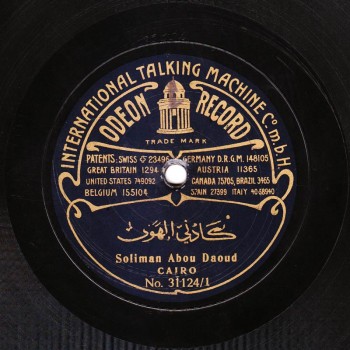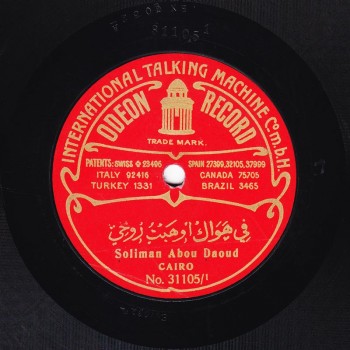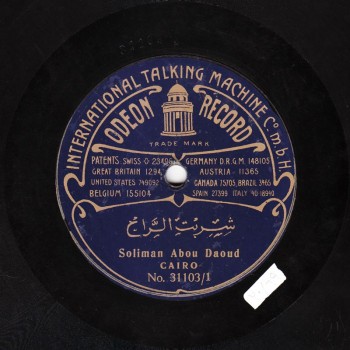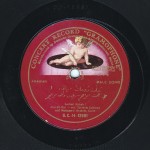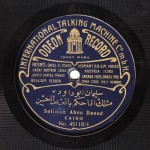The Arab Music Archiving and Research foundation (AMAR), in collaboration with the Sharjah Art Foundation (SAF), presents “Min al-Tārīkh”.
Dear listeners, welcome to a new episode of “Min al-Tārīkh”.
Today, we will resume our discussion about Sulaymān Afandī Abū Dāwūd with Prof. Frédéric Lagrange.
Which record company first recorded Sulaymān Abū Dāwūd? And when?
We unfortunately do not have a precise chronicle of Odeon, which I think is the record company he started recording with… not Zonophone / Gramophone.
Dear Sir, here are the confirmed dates:
In July 1905, he recorded with Favorite Recordings 5 discs of 5 dawr: “Albī fī ḥubbak lēh mashghūl”, “Dalālak yā gamīl”, “Dalāl el-ḥubb”, “Ḥabbēt gamīl”, and “Ṭāl el-gafa min maḥbūbī”.
In December 1905, i.e. 6 months later, he recorded with Zonophone around 6 discs that appeared in their 1907 catalogue.
Other “addition” recordings made either during the same campaign or later on –yet most probably during the same campaign– were published later.
You would be right if you said that Odeon’s recordings were made before Zonophone’s and Favorite’s. Yet, what is the criterion you adopted?
I think he seems to be less experienced in and less used to this new media in the first recordings than in those he made later.
There is more than one criterion:
First, the takht accompanying him in his Odeon recordings only includes a qānūn, unlike Odeon’s takht later on that included Sayyid al-Suwaysī and ‘Abd al ‘Azīz al-Qabbānī, later joined by ‘Alī ‘Abduh Ṣāliḥ. The one-instrument takht implies that this was a test recording, exactly like the first Gramophone recordings.
Recording his first discs with Odeon (matrix # EX 26 and EX 27…etc.) with such a takht resembles Zonophone’s recordings made in 1903 and 1904. This is why I think that Odeon’s recordings were made during the same period. Moreover, the quality is not as good as that of the Sama‘ al-Mulūk recordings –daughter company of Bekka– of Sheikh Yūsuf Al-Manyalāwī for example.
Often, the acquaintance of a muṭrib with this new medium shows in the qafla at the end of the disc, in whether he was able to sum up the dawr convincingly, and to distribute all its parts evenly over both sides of the disc.
A comparison between the first Odeon recordings and those made later highlights his lack of recording experience in the first ones, while it obviously improved in those he made later.
Actually, he became experienced to such a point that he was able to invent this pleasant jest heard in his later Odeon recordings.
The most beautiful recordings of Sulaymān Abū Dāwūd –who recorded with Meshian, Favorite, Orfeon, Zonophone, …almost with all the existing record companies except for Gramophone when it became Gramophone–, were his Odeon recordings made during their Golden era. Who were the members of the takht accompanying him?
The takht included Ḥāj Sayyid al-Suwaysī (‘ūd), ‘Abd al-‘Azīz Afandī al-Qabbānī (qānūn), ‘Alī ‘Abduh Ṣāliḥ (nāy), and no percussions.
I think this story about Sayyid al-Suwaysī is mentioned in the memoirs of Sāmī al-Shawwā, isn’t it?
Ḥāj Sayyid al-Suwaysī?
The only document I have is a single recording of the band playing to the bashraf –the same band obviously, as proved by the voice–, with a label carrying the names of the instrumentalists I mentioned.
Among the very valuable information about Sulaymān Abū Dāwūd, these few lines in the memoirs of Sāmī al-Shawwā make one wonder if Sulaymān Abū Dāwūd was among the muṭrib from Alexandria and not those from Cairo. Because Sāmī al-Shawwā wrote that he reached Alexandria in the first week of the month of Ramadan in 1904. There, he met Iliyyā Abū Māḍī who was 18 years’ old at most, and found 5 Egyptian takht, all of which only included a single violin played by the great Ilyās Mashāṭī who almost worked exclusively with Sulaymān Abū Dāwūd. Maybe Egyptian takht did not include a kamān then because they relied on the nāy that was chosen over the kamān because the latter instrument was only played by a handful of musicians after it had entered Egypt with Antoine al-Shawwā on the occasion of the wedding of Khedive Ismā‘īl’s sons.
There is some kind of prejudice towards the genius of Ibrāhīm Sahlūn in these lines, don’t you think?
As well as towards Ḥasan al-Jāhil before him… well… they were written by Sāmī al-Shawwā… we have to forgive him.
Sulaymān Abū Dāwūd might have been from Alexandria… We do know that the first recording campaign took place in Alexandria.
Ismā‘īl Ḥāfiẓ was the star of this recording campaign, i.e. he is the artist who recorded the most during the first recording campaign, that included neither a violin nor a nāy, only a ‘ūd and a qānūn.
Sulaymān Abū Dāwūd’s most beautiful recordings are undoubtedly those made by Odeon –those numbered #31 or in the #40s.
Odeon is also the company he recorded the most with –more than 60 discs.
The recordings of this invaluable collection include:
First and foremost, his unique performance of dawr “El-bulbul gānī we-allī” that is completely different from Sheikh Yūsuf Al-Manyalāwī’s. It does not include the pigeon cooing ornamentation, yet Sulaymān Abū Dāwūd added many personal variations.
He made it dance.
Indeed, yet not in the way Salāma Ḥigāzī made a dawr dance, as Sulaymān Abū Dāwūd’s performance did not include the same experience or dancing spirit.
Salāma Ḥigāzī exemplifies the fusion between tragedy and dancing: the dance of the slaughtered pigeon. The dancing spirit in Sulaymān Abū Dāwūd’s performance is closer to ṭarab and more sober.
And includes less drama.
(♩)
I also think that he is the only one who recorded Al-Maslūb’s not well-known dawr “Fī hawāk awhabti rūḥī” to the kardān…
Shall we listen to it?
(♩)
I think Sulaymān Abū Dāwūd is also the only one who recorded dawr “Shribt el-rāḥ fī rawḍ el-unsi ṣāfī” also to the kardān. All the others recorded dawr “Shribt el-ṣabr min ba‘d el-taṣāfī” to the ‘ushshāq…
Shall we listen to it too? … We would have then listened to two dawr to the kardān today…
(♩)
Let us go to the bayyātī maqām now.
Here is dawr “Zāhī gamālak fatannī” –composer unknown–, another rare example of a dawr of which we know nothing. Yet it is indeed a dawr, unlike the forms veering between a dawr and a ṭaqṭūqa, and the early dawr.
“Zāhī gamālak” is among the rare dawr he recorded that include a drama aspect.
Possibly…
His recording of this dawr is different from his usual recordings.
I think the perfect conclusion would be Sulaymān Abū Dāwūd’s recording of “Kādnī el-hawa” –or “Khādnī el-hawa” as he pronounces it–. He is the only one that sang to the sīkāh note in this dawr.
… And he insists on the “kh” in “Khādnī el-hawa”.
(♩)
Dear listeners,
We have reached the end of today’s episode of “Min al-Tārīkh”.
We will meet again in a new episode.
Ḥāḍir (Yes, Sir).
“Min al-Tārīkh” is brought to you by Mustafa Said.
- 221 – Zakariyya Ahmed – 12 (1/9/2022)
- 220 – Zakariyya Ahmed – 11 (1/9/2022)
- 219 – Zakariyya Ahmed – 10 (11/25/2021)
- 218 – Zakariyya Ahmed – 9 (10/26/2021)
- 217 – Zakariyya Ahmed – 8 (9/24/2021)
- 216 – Zakariyya Ahmed – 7 (9/4/2021)
- 215 – Zakariyya Ahmed – 6 (8/28/2021)
- 214 – Zakariyya Ahmed – 5 (8/6/2021)
- 213 – Zakariyya Ahmed – 4 (6/26/2021)
- 212 – Zakariyya Ahmed – 3 (5/27/2021)
- 211 – Zakariyya Ahmed – 2 (5/1/2021)
- 210 – Zakariyya Ahmed – 1 (4/28/2021)
- 209 – W-al-Lāhi lā astaṭī‘u ṣaddak 2 (4/6/2017)
- 208 – W-al-Lāhi lā astaṭī‘u ṣaddak 1 (3/30/2017)
- 207 – Bashraf qarah baṭāq 7 (3/23/2017)

